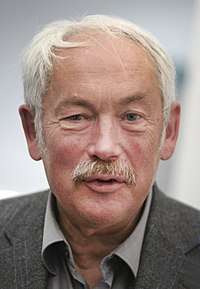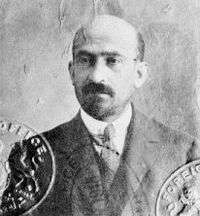Technische Universität Darmstadt
|
Technische Universität Darmstadt | |
 | |
Former names | Technische Hochschule Darmstadt |
|---|---|
| Type | Public |
| Established | 1877[1] |
| Budget | € 451.9 million[2] |
| President | Hans Jürgen Prömel[3] |
Academic staff | 2,756[2] |
Administrative staff | 2,014[2] |
| Students | 26,360[2] |
| Location |
Darmstadt, Hessen, Germany 49°52′30″N 8°39′23″E / 49.874995°N 8.656517°ECoordinates: 49°52′30″N 8°39′23″E / 49.874995°N 8.656517°E (inner city)49°51′40″N 8°40′50″E / 49.86113°N 8.68056°E (Lichtwiese) |
| Campus | Urban/Suburban |
| Affiliations | |
| Website | www.tu-darmstadt.de |
The Technische Universität Darmstadt (unofficially Technical University of Darmstadt or Darmstadt University of Technology), commonly referred to as TU Darmstadt, is a research university in the city of Darmstadt, Germany. It was founded in 1877 and received the right to award doctorates in 1899. In 1882 it was the first university in the world to set up a chair in electrical engineering, and founded the first faculty for it in 1883.[4] Nobel laureate Albert Einstein once recommended this university. TU Darmstadt's alumni include 2 Nobel laureates and 2 Leibniz Prize winners.
TU Darmstadt is a member of TU9, a network of the most notable German Technische Universitäten (universities of technology).[5]
History
On 10 October 1877 Louis IV, Grand Duke of Hesse, elevated the Polytechnische Schule to Technische Hochschule zu Darmstadt and thereby raised the status of this educational institution to that of a university so that the Abitur (a school leaving certificate from German Gymnasium schools qualifying for university admission or matriculation) became a requirement for admissions. In 1899 the Technische Hochschule Darmstadt was granted the right to award doctorates.[6]
Early beginnings
The University's history is varied: its early phases began with the Höhere Gewerbschule (Higher Trade School), which was founded in 1836 and received its own building near the 'Altes Pädagog' on Kapellplatz in 1844, followed by the Technische Schule (Technical School) in 1864 and the Großherzoglich Hessische Polytechnische Schule (Grand Ducal Hessian Polytechnic) in 1868. At that time, heated discussions were continually held in political circles on the issue as to whether such a poor state as the Grand Duchy of Hessen could afford a technically oriented higher educational institution, or even a polytechnic. After the foundation of Technische Hochschule Darmstadt in 1877, student numbers kept on being so low that in the years from 1881 to 1882 there were long debates in public about closing down the University. In this difficult situation, the local government and the University made the courageous decision to set up the first chair of electrical engineering worldwide. Thus the Faculty of Electrical Engineering came into being as the sixth faculty of the Technische Hochschule Darmstadt, which was a novelty in academia, because until then no other university had had such a faculty. This forward-looking higher education policy paved the way for Darmstadt to take up a leading position in the rapidly developing field of electrical engineering, which in turn led to a continuously rising number of students, so that the closure of the university never was demanded again.
First steps as a university
In 1895 new buildings were opened in Hochschulstrasse: the Altes Hauptgebäude (the 'Old Main Building' of the University) and an institute building directly opposite. During the two decades before the World War I, all disciplines of the university underwent diversification and expansion. New disciplines such as paper making and cellulose chemistry were introduced, and as early as 1913 a Chair of Aeronautics and Flight Mechanics was set up.
Meanwhile, the political climate had become stormier, and a growing political polarization exploded in Darmstadt over the question of foreign students. The Technische Hochschule Darmstadt had an extraordinarily large number of foreign students. In 1906, for instance, as many as three quarters of the electrical engineering students were from abroad, mainly from states of eastern Europe.
After the World War I there was an urgent need for reform of the education system at Technische Hochschule Darmstadt, which was seen as a prerequisite for meeting the requirements of a modern industrial society. Intense discussions were held on the aim of extending the curriculum beyond the purely technical education in order to prepare the engineer for his leading role in society. A concrete step in this direction was taken in 1924, when the 'General Faculty', which until then had combined all the non-technical subjects, was divided into a Department of Mathematics and Natural Science and a Department of Cultural Studies and Political Science. Moreover, the measures taken to provide students with knowledge outside their own field of study included the upgrading of Economics and the creation of professorships in political science, history of technology and sociology.
Restart after WW II
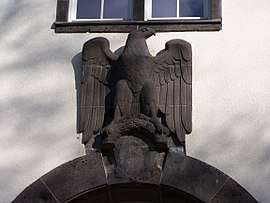
On the night of 11/12 September 1944, eighty per cent of the city, including many of the university's buildings, were destroyed during a bomb attack. For a short period in 1945 parts of the TH Darmstadt may have been closed by decree of the Allies before it was reopened in 1946. The electrical engineering department remained continuously functional, doing work under contract with the U.S. Army to build components of the V-2 guidance system. "But we have to be careful how we word this production order because we don't want the Russians to know that we are cranking up the V-2 system."[7] In spite of the difficult post-war situation, university staff and students alike managed to settle down to university work in the severely damaged buildings, which had to be used as a makeshift solution.
As early as 1947, Technische Hochschule Darmstadt hosted the first Internationaler Kongress für Ingenieurausbildung (International Congress on Engineering Education), at which the participants discussed the moral responsibility of the technical intelligentsia and of the scientific elite in politics and society. In view of the disastrous consequences of the war, the participants (with the exception of the Americans, who had already contracted with THD faculty to continue weapon development), committed themselves henceforth to do research and teaching in engineering and scientific disciplines solely for the peaceful development of mankind.
1. Technical Science as Ethical and Cultural Task. 2. Present State and Tendencies of Development in Engineering Education Throughout the World. 3. Selection of Students and Social Problems.[8]
The speech delivered by Dr. James R. Newman, Director of American Military Government of Hessen, however, made no mention of such a commitment, while stating that:
"An interchange of these [past experience], together with ideas and methods of education along engineering lines, will aid greatly, not only in the reconstruction of battle torn countries, but also in the bringing about of a universal understanding and mutual respect, and the charity which have prevented the understanding, the tolerance, the respect, and the charity so necessary for the peace, happiness, and contentment that is the dream of every human being on this earth."[9]
The post-war period of reconstruction was largely based on a major development programme in the 1960s, by means of which universities and the state reacted to the continuously rising numbers of students. Since almost no land was available in the city centre for new construction projects, the decision was taken in 1963 to use the 'Lichtwiese' (a former airfield on the outskirts of the city) as a site for building extensions to the Technische Hochschule. Thus in the late 1960s and in the early 1970s numerous buildings, including a new student cafeteria, were erected there and ultimately became the university's second campus.
University reforms in the 1970s
After 1968 the university reform, having been initiated by the student movement, was beginning to take shape both at a national and a regional level. It aimed at creating clear university structures and the involvement of all university members in decision-making processes. In 1970 the Hessisches Hochschulgesetz (Higher Education Law of the Federal State of Hessen) came into force. These gave Technische Hochschule Darmstadt, along with other Hessian universities, a new structure based on the introduction of a presidential statute and a unified administration as well as the subdivision of the university structure into departments.
In the mid 1970s there was another rapid rise in student numbers. Staff development, however, lagged far behind, resulting in inevitable restrictions on admission imposed either by the central government or by the University. Regardless of the staff's heavy workload, the TH Darmstadt managed to set the course for the future, as evidenced by the School of Information Science, established in 1974, the Zentrum für Interdisziplinäre Technikforschung (Centre for Interdisciplinary Studies on Technology), founded in 1987, and the Department of Materials Science, established in 1989. This department has been housed in a new building on the Lichtwiese since 1996.
Renaming
By the end of the 20th century, Technische Hochschule Darmstadt had been granted the legal status of a university, and had been offering a correspondingly wide range of subjects, for over a hundred years. For these reasons, and also with the objective of sharpening public awareness of the university's status at home and abroad, Technische Hochschule Darmstadt was renamed Technische Universität Darmstadt (which is also its official English name albeit often called Darmstadt University of Technology) on 1 October 1997. This name change was partly prompted by misunderstandings that had occurred in English-speaking countries, where Technische Hochschule had often been mistakenly transliterated as 'Technical High School', providing a totally misleading connotation.
Autonomy and TUD Law
On 1 January 2005 the first version of the TUD Law applied making TU Darmstadt the first German public university to be given administrative autonomy. New administrative structures were put into place, and their success is being evaluated. For instance, the university can now autonomously administer its budget and buildings. Also, the university can hire professors and negotiate their salaries by itself. Formerly this was done by the State of Hessen. The TUD law in its current state has legal force up to 31. December 2014.[10]
Campuses
The University, with 140 Buildings and an area of property of 600 acres (2.4 km2),[2] is concentrated at the two campuses, Inner City and Lichtwiese. But individual facilities can be found in other parts of Darmstadt and in Griesheim, a neighboring town.[11]

Inner City Campus
This campus lies very central in Darmstadt and is easily reachable by tram and bus from every part of the city. The departments located here are Electrical Engineering and Information Technology (18), History and Social Sciences (2), Human Sciences (3), Computer Science (20), Mathematics (4), Physics (5) and Law and Economics (1).[12]
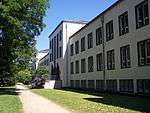 Robert Piloty Building, named after Robert Piloty, a German computer scientist and Professor of Electrical Engineering at TU Darmstadt, used by the Department of Computer Science, 2006
Robert Piloty Building, named after Robert Piloty, a German computer scientist and Professor of Electrical Engineering at TU Darmstadt, used by the Department of Computer Science, 2006 Altes Hauptgebäude of Technische Universität Darmstadt, 2008
Altes Hauptgebäude of Technische Universität Darmstadt, 2008 Kantplatz, Darmstadt, 2007
Kantplatz, Darmstadt, 2007 Darmstadt former Ducal Palace, now part of TU Darmstadt, with market square
Darmstadt former Ducal Palace, now part of TU Darmstadt, with market square Campus Square, Inner City Campus of TU Darmstadt, with University Library and sculpture "Bueste" by Franz Bernhard
Campus Square, Inner City Campus of TU Darmstadt, with University Library and sculpture "Bueste" by Franz Bernhard Main Entrance and Administrative Building, City Campus TU Darmstadt 2018
Main Entrance and Administrative Building, City Campus TU Darmstadt 2018
Campus Lichtwiese
The Lichtwiese lies in the eastern part of Darmstadt. It is reachable by bus and a nearby train station. The departments located here are Architecture (15), Civil Engineering and Geodesy (13), Chemistry (7), Mechanical Engineering (16) and Materials and Earth Sciences (11).[13]
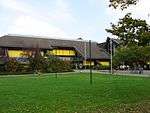 Canteen at Campus Lichtwiese, 2007
Canteen at Campus Lichtwiese, 2007 Giant gear in front of the mechanical engineering building, 2007
Giant gear in front of the mechanical engineering building, 2007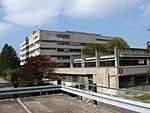 Building used by the Department of Architecture, 2007
Building used by the Department of Architecture, 2007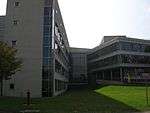 Institute of Materials Science, TU Darmstadt Lichtwiese Campus
Institute of Materials Science, TU Darmstadt Lichtwiese Campus Lecture Halls and Library Building at Lichtwiese Campus
Lecture Halls and Library Building at Lichtwiese Campus
Botanical garden
The Botanical Garden of the TU Darmstadt is located near the Lichtwiese Campus and the Department of Biology (10) is located here as well. With additional buildings of the Department of the Materials and Earth Sciences (11)[14] and parts of the faculty of Chemical Engineering and Biotechnology of the Darmstadt University of Applied Sciences (h_da)[15] it makes for an additional smaller campus.
- Greenhouse, 2009
 Botanical Garden Campus of TU Darmstadt
Botanical Garden Campus of TU Darmstadt
Griesheim
Since 2005, TU Darmstadt owns the August Euler Airfield for scientific purposes. It is named after its founder August Euler, a pioneer aviator.[16] The airfield is not only used to start planes, but also to conduct research on topics where wide spaces are needed, for example driver assistance systems and automotive lighting are being tested here.[17] Located near the airfield are the wind tunnels of TU Darmstadt.[18]
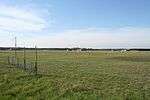 August Euler Airfield, 2011
August Euler Airfield, 2011
Academic profile
Departments and fields of study
Typical for a university of technology, ten out of its 13 academic departments (Fachbereiche) are in engineering, natural sciences, and mathematics, while three departments are in the social sciences and the humanities. The departments (with number of the department) are:[19]
- Architecture (15)
- Civil and Environmental Engineering (13)
- Biology (10)
- Chemistry (7)
- Electrical Engineering and Information Technology (18)
- History and Social Sciences (2)
- Human Sciences (3)
- Computer Science (20)
- Mechanical Engineering (16)
- Materials and Earth Sciences (11)
- Mathematics (4)
- Physics (5)
- Law and Economics (1)
In addition, there are five fields of study (Studienbereiche), which offer interdisciplinary degree courses in which students take lectures in multiple departments:[19]
- Computational Engineering
- Energy Science and Engineering
- Information Systems Engineering
- Mechanics
- Mechatronics
Altogether, TU Darmstadt offers about 100 courses of studies.[20] Beyond Bachelor's and Master's degrees, it also offers degree courses for teaching positions at German vocational schools and gymnasiums.[21]
Research
Research is being carried in the departments as well as in six Profile Areas.[22] Moreover, at the TU Darmstadt there are several Sonderforschungsbereiche (SFB, collaborative research units)[23] as well as several Graduiertenkollegs (graduate schools),[24] funded by Deutsche Forschungsgemeinschaft.
The university has attracted a considerable number of national and international research institutions to the Wissenschaftsstadt Darmstadt (Darmstadt - City of Science). Among them are:
- GSI Helmholtz Centre for Heavy Ion Research
- Fraunhofer Institute for Secure Information Technology SIT[25]
- Fraunhofer Institute for Computer Graphics Research IGD[26]
- Fraunhofer Institute for Structural Durablity and System Reliability[27]
- European Space Operations Centre
- EUMETSAT.
TU Darmstadt collaborates with these research institutes on a broad basis. For instance, TU Darmstadt and GSI agreed on a strategic partnership, which includes collaboration in the establishment of the FAIR Facility for Antiproton and Ion Research.[28] With Fraunhofer SIT as well as Hochschule Darmstadt, TU Darmstadt is partnering in the national Center for Research in Security and Privacy.[29]
TU Darmstadt is involved in the German Excellence Initiative. This initiative sponsored the Cluster of Excellence Smart Interfaces (2007-2014), the Graduate School of Computational Engineering and the Graduate School of Excellence Energy Science and Engineering. TU Darmstadt is also partially involved with the Cluster of Excellence Normative Orders, based at Goethe University Frankfurt.[30]
Research profile
TU Darmstadt defined six Profile Areas which characterize its research profile:
International life
With 18% (2017),[37] the percentage of international students at the TU Darmstadt is clearly higher than the average of German universities of 13% (2017/18).[38] TU Darmstadt maintains partnership agreements with universities in 53 countries world-wide, which enable students to come to TU Darmstadt and to go abroad within their course of studies.[39] With Tongji University Shanghai, Virginia Polytechnic Institute and State University, Blacksburg, Virginia, and Graz University of Technology, TU Darmstadt has developed strategic partnerships.[40]
The university offers international (English-language) Master's programs[41] and a broad range of double degree programs.[42] The Joint Master Programme "International Cooperation in Urban Development (Mundus Urbano)" is offered together with Université Pierre Mendès-France, International University of Catalonia, and Universita degli Studi di Roma Tor Vergata as part of the Erasmus Mundus programme of the European Commission.[43]
Knowledge transfer
TU Darmstadt pursues multiple paths for knowledge and technology transfer. The university's start-up center HIGHEST (Home of Innovation, GrowtH, EntrepreneurShip and Technology Management) provides support for founders from the university, with a focus on digital and high-tech start-ups.[44] In strategic alliances, the cooperation in research and transfer with large corporates is developed. Strategic partners of TU Darmstadt are Siemens, Merck, Bosch, Continental AG, and Deutsche Bahn.[45] For cooperation with small and medium sized companies, TU Darmstadt set up a structured collaboration with Hessenmetall, the regional association of the machinery, electronic and automotive industry.[46] Research funds from industry were 37 million Euros in 2017.[47]
Student life
Activities
TU Darmstadt offers various recreational sports courses and operates three sports halls, a sports stadium including various fields, a swimming pool, and a fitness studio. There are manifold accredited student groups, ranging from the Formula SAE TU Darmstadt Racing Team (DART), Akaflieg Darmstadt, and Chaos Computer Club to a theater group, an orchestra, and the campus radio AudioMax.[48] The annual job fair konaktiva, which connects approximately 10,000 students with potential employers, is organized by volunteer students.[49]
Students' representation
Students at TU Darmstadt are represented by the students' parliament (Studierendenparlament, StuPa), which is elected annually and in turn elects the General Students' Committee (Allgemeiner Studierendenausschuss, AStA). The AStA is the students' government and engages in university politics and provides social and economic counseling for students. Moreover, it runs the café 60,3qm ("60.3 square meters"), a beer garden and a club in the Ducal Palace, a store for office supplies, and a bicycle garage. In addition to the regular university curriculum, students can attend various non-credit courses held by students and coordinated by the AStA.
Complementing the General Students' Committee, which represents all students enrolled at TU Darmstadt, the students of each department (Fachschaft) are represented by an elected students' council (Fachschaftsrat). Students of the Fachschaft participate in a number of committees of their department, such as the department's council (Fachbereichsrat), which consists of professors, students, academic staff and administrative staff.
Legends
Since the 1970s, the fictitious student Fritz Filter passed numerous examinations at the Department of Architecture before graduating with a Diplom degree in 2004. His thesis featured the design of the department building. Fritz Filter turned in multiple further architecture theses since then.[50]
Housing
A survey determined that in summer semester 2009 students in Darmstadt paid an arithmetic mean of 321 euros a month for rent, heat and utilities. With the German average being 281 euros at the time, this made Darmstadt the sixth most expensive city for students in Germany.[51] This value only includes students not living at home, not married and pursuing their first degree (referred to as "normal student" in the survey).[52] In this semester, on national average, 23.4% lived with their parents, 12.4% lived in a hall of residence, 1.6% were lodgers, 25.8% were sharing a flat with others, 17.2% were living alone and 19.9% were sharing a flat with their partner.[53]
There are 2,512 beds in 9 halls of residence offered by the state-run student affairs organization Studierendenwerk Darmstadt for students of TU Darmstadt and Darmstadt University of Applied Sciences.[54]
Reputation and ranking
Research and teaching in a nationwide comparison
Within Germany, the TU Darmstadt (in the overall assessment) and its faculties (in individual grades) regularly occupy top positions in rankings. The university is considered to be the best university for business informatics according to the Wirtschaftswoche-Hochschulranking 2018, which asks human resources staff of small, medium and large companies.
Research and teaching in a global comparison
By QS Graduate Employability Rankings 2019, TU Darmstadt is ranked 3rd in Germany, 22nd in Europe and at 78th place (overall) in the world.
Notable faculty and alumni
- Marc Baldus (born 1967), physicist, expert in NMR spectroscopy
- Günter Behnisch (1922–2010), architect (Olympic Stadium (Munich))
- Hanns-Peter Boehm (born 1928), chemist and a pioneer of graphene research
- Kurt H. Debus (1908–1983), rocket scientist and first Kennedy Space Center director
- Mikhail Dolivo-Dobrovolsky (1862–1919), inventor of the three-phase electrical motor
- José Luis Encarnação (born 1941), computer scientist, inventor of the Graphical Kernel System
- Christoph Franz (born 1960), chairman of Roche
- Paul Friedländer (1857–1923), chemist
- Josef Ganz (1898–1967), Jewish automotive engineer, father of the original "Volkswagen"
- Peter Grünberg (1939-2018), physicist, discoverer of the Giant magnetoresistance effect, Nobel laureate (2007)
- Gerhard Hennige (born 1940), Olympic medal winner
- Gerhard Herzberg (1904–1999), chemist, physicist and Nobel laureate (1971)
- Kurt Hohenemser (1906-2001), aerospace engineer and pioneer in helicopter design
- Franz-Josef Kemper (born 1945), sociologist and track-and-field athlete
- Karl Küpfmüller (1897–1977), electrical engineer
- El Lissitzky (1890–1941), architect and designer
- Ernst May (1886–1970), architect and city planner (New Frankfurt)
- Ernst Neufert (1900–1986), architect
- Gustav Niemann (1899–1982), mechanical engineer
- Fritz von Opel (1899–1971), rocket pioneer
- Carl Adam Petri (1926–2010), inventor of the Petri nets
- Karl Plagge (1897–1957), Righteous Among the Nations
- William Prager (1903-1980), Applied Mathematician[55]
- Wolfgang Rösch (born 1959), priest, vicar general of Limburg
- Harald Rose (born 1935), physicist, laureate of the Wolf Prize in Physics
- Bert Rürup (born 1943), former chairman of the German Council of Economic Experts
- Frank Schimmelfennig (born 1963), political scientist
- Bernhard Schlink (born 1944), former judge and writer (The Reader)
- Ernst Schröder (1841–1902), mathematician
- Gerhard M. Sessler (born 1931), electrical engineer and inventor of the electret microphone
- Thomas Sieverts (born 1934), architect and urban planner
- John Tu (born 1940), co-founder of Kingston Technology
- Chaim Weizmann (1874–1952), chemist and first president of Israel
- Rudolf Wille (1937-2017), mathematician
- Johann Dietrich Wörner (born 1954), civil engineer, Director General of the European Space Agency
- Hermann Zapf (1918–2015), typeface designer (Palatino, Optima, Zapfino)
- Eduard Zintl (1898–1941), chemist and discoverer of the Zintl phase
- Jovanka Bončić-Katerinić (1897-1966), Serbian architect, 1st woman engineer in Germany
Notes and references
- ↑ Who We Are Archived 17 September 2012 at the Wayback Machine. TU Darmstadt Homepage. Visited 6 October 2012
- 1 2 3 4 5 "Facts and Figures". Technische Universität Darmstadt. Retrieved 2017-04-20.
- ↑ The Presidium of Technische Universität Darmstadt TU Darmstadt Homepage. Visited 6 October 2012
- ↑ History of the department of Electrical Engineering: "Archived copy". Archived from the original on 28 June 2011. Retrieved 20 April 2011. (German)
- ↑ "Alliances and Networks". Technische Universität Darmstadt. Retrieved 2017-04-15.
- ↑ "Der Anfang war international, TU Darmstadt Homepage". Archived from the original on 23 October 2008. Retrieved 7 October 2012.
- ↑ U.S. Air Force Oral History Interview of Helmut Kuerschner by Dr. Hasdorff. K239.0512-1648, pp.12-14
- ↑ IKIA: INTERNATIONALER KONGRSS FÜR INGENIEUR AUSBILDUNG Darmstadt 31. Juli bis 9. August 1947, 1949, EDUARD ROETHER VERLAG; DARMSTADT; P xiii;
- ↑ IKIA, pp. 5-6
- ↑ jlr-TUDGHEV2P3 Gesetz zur organisatorischen Fortentwicklung der Technischen Universität Darmstadt (TUD-Gesetz) Hessenrecht Rechts- und Verwaltungsvorschriften, Hessian Homepage with all current hessian legal regulations. Visited 7 October 2012
- ↑ TU Darmstadt – Gesamtübersicht der Standorte (subpages used as well) TU Darmstadt Homepage. Visited 6 October 2012
- ↑ TU Darmstadt – Standort Stadtmitte Übersicht Homepage TU Darmstadt. Visited 6 October 2012
- ↑ TU Darmstadt – Standorte Lichtwiese, Botanischer Garten, Hochschulstadion Übersicht Homepage TU Darmstadt. Visited 6 October 2012
- ↑ B – Standort Botanischer Garten TU Darmstadt Homepage. Visited 7 October 2012
- ↑ Schnittspahnstraße Lageplan Archived 15 October 2012 at the Wayback Machine. Darmstadt University of Applied Sciences Homepage. Visited 7 October 2012
- ↑ August-Euler-Flugplatz Darauf muss man fliegen! Archived 2 November 2012 at the Wayback Machine. TU Darmstadt Homepage. Visited 7 October 2012
- ↑ Forschungslabor unter freiem Himmel Archived 17 April 2012 at the Wayback Machine. TU Darmstadt Homepage. Visited 7 October 2012
- ↑ Einrichtungen Homepage of the fluid mechanics and aerodynamics institute of the department of Mechanical engineering at TU Darmstadt. Visited 7 October 2012
- 1 2 The TU-Darmstadt’s Departments and Fields of Study TU Darmstadt Homepage. Visited 11 March 2018
- ↑ "TU Darmstadt: Facts and Figures". TU Darmstadt. Retrieved 2018-03-11.
- ↑ "TU Darmstadt: Degree Programs". TU Darmstadt. Retrieved 2018-03-12.
- ↑ Darmstadt, Technische Universität. "Research profile: Profile areas and profile topics". Technische Universität Darmstadt. Retrieved 2018-03-10.
- ↑ "TU Darmstadt Collaborative Research Centres". TU Darmstadt. Retrieved 2018-03-10.
- ↑ "TU Darmstadt Research Training Groups". TU Darmstadt. Retrieved 2018-03-10.
- ↑ "Fraunhofer SIT". Fraunhofer SIT. Retrieved 2018-03-10.
- ↑ "Fraunhofer IGD | Fraunhofer Institute for Computer Graphics Research IGD". www.igd.fraunhofer.de. Retrieved 2018-03-10.
- ↑ "English - Fraunhofer LBF". www.lbf.fraunhofer.de. Retrieved 2018-03-10.
- ↑ Darmstadt, Technische Universität (2015-12-18). "Kooperation mit neuer Energie". Technische Universität Darmstadt (in German). Retrieved 2018-03-10.
- ↑ "CRISP – Center for Research in Security and Privacy Darmstadt". CRISP. Retrieved 2018-03-10.
- ↑ Excellence Initiative Archived 13 February 2015 at the Wayback Machine. TU Darmstadt Website. Visited 15 April 2015
- ↑ Darmstadt, Technische Universität. "Profile Area Thermo-Fluids & Interfaces". Technische Universität Darmstadt. Retrieved 2018-03-10.
- ↑ "Profile Area Future Energy Systems". TU Darmstadt. Retrieved 2018-03-10.
- ↑ "Profile Area From Material to Product Innovation". TU Darmstadt. Retrieved 2018-03-10.
- ↑ "Profile Area Cybersecurity". TU Darmstadt. Retrieved 2018-03-10.
- ↑ "Profile Area Internet and Digitisation". TU Darmstadt. Retrieved 2018-03-10.
- ↑ Matter and Radiation Science TU Darmstadt Website. Visited 15 April 2015
- ↑ "TU Darmstadt Facts and Figures". TU Darmstadt. Retrieved 2018-03-10.
- ↑ Studierende Insgesamt nach Bundesländern und tiefer gegliederten Angaben Statistisches Bundesamt (Federal Statistical Office of Germany). Visited 6 October 2012
- ↑ "TU Darmstadt Partner Universities". TU Darmstadt. Retrieved 2018-03-10.
- ↑ "TU Darmstadt International Strategic Partner Universities". TU Darmstadt. Retrieved 2018-03-10.
- ↑ "TU Darmstadt Master Programs". TU Darmstadt. Retrieved 2018-03-10.
- ↑ "TU Darmstadt Double Degree Programs". TU Darmstadt. Retrieved 2018-03-10.
- ↑ "Advanced Master of Science Programme – International Cooperation in Urban Development (Mundus Urbano)". Technische Universität Darmstadt (in German). Retrieved 2017-04-15.
- ↑ "TU Darmstadt Start-up Center HIGHEST". TU Darmstadt. Retrieved 2018-03-10.
- ↑ "TU Darmstadt Strategic Partnerships Transfer". TU Darmstadt. Retrieved 2018-03-10.
- ↑ "TU Darmstadt Collaboration Hessenmetall". TU Darmstadt. Retrieved 2018-03-10.
- ↑ "TU Darmstadt Third Party Research Funds". TU Darmstadt. Retrieved 2018-03-10.
- ↑ "Engagement". Technische Universität Darmstadt (in German). Retrieved 2017-09-14.
- ↑ "Über uns". www.konaktiva.tu-darmstadt.de (in German). Retrieved 2017-09-14.
- ↑ Bender, Justus (2009-12-01). "TU Darmstadt: Der Student, der niemals lebte". Die Zeit (in German). ISSN 0044-2070. Retrieved 2017-10-04.
- ↑ The Economic and Social Conditions of Student Life in the Federal Republic of Germany in 2009 (Selected results) Page 22, sozialerhebung.de (HIS Hochschul-Informations-System GmbH). Visited 7 October 2012
- ↑ The Economic and Social Conditions of Student Life in the Federal Republic of Germany in 2009 (Selected results) Page 14, sozialerhebung.de (HIS Hochschul-Informations-System GmbH). Visited 7 October 2012
- ↑ The Economic and Social Conditions of Student Life in the Federal Republic of Germany in 2009 (Selected results) Page 30, sozialerhebung.de (HIS Hochschul-Informations-System GmbH). Visited 7 October 2012
- ↑ "Zu Hause im Studierendenwerk". Studierendenwerk Darmstadt (in German). Retrieved 2017-09-14.
- ↑ http://library.brown.edu/cds/portraits/display.php?idno=179
External links
| Wikimedia Commons has media related to Technische Universität Darmstadt. |
